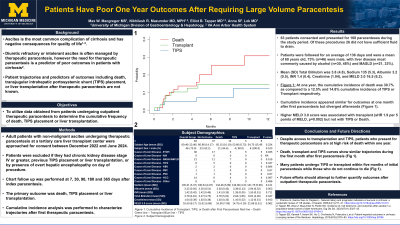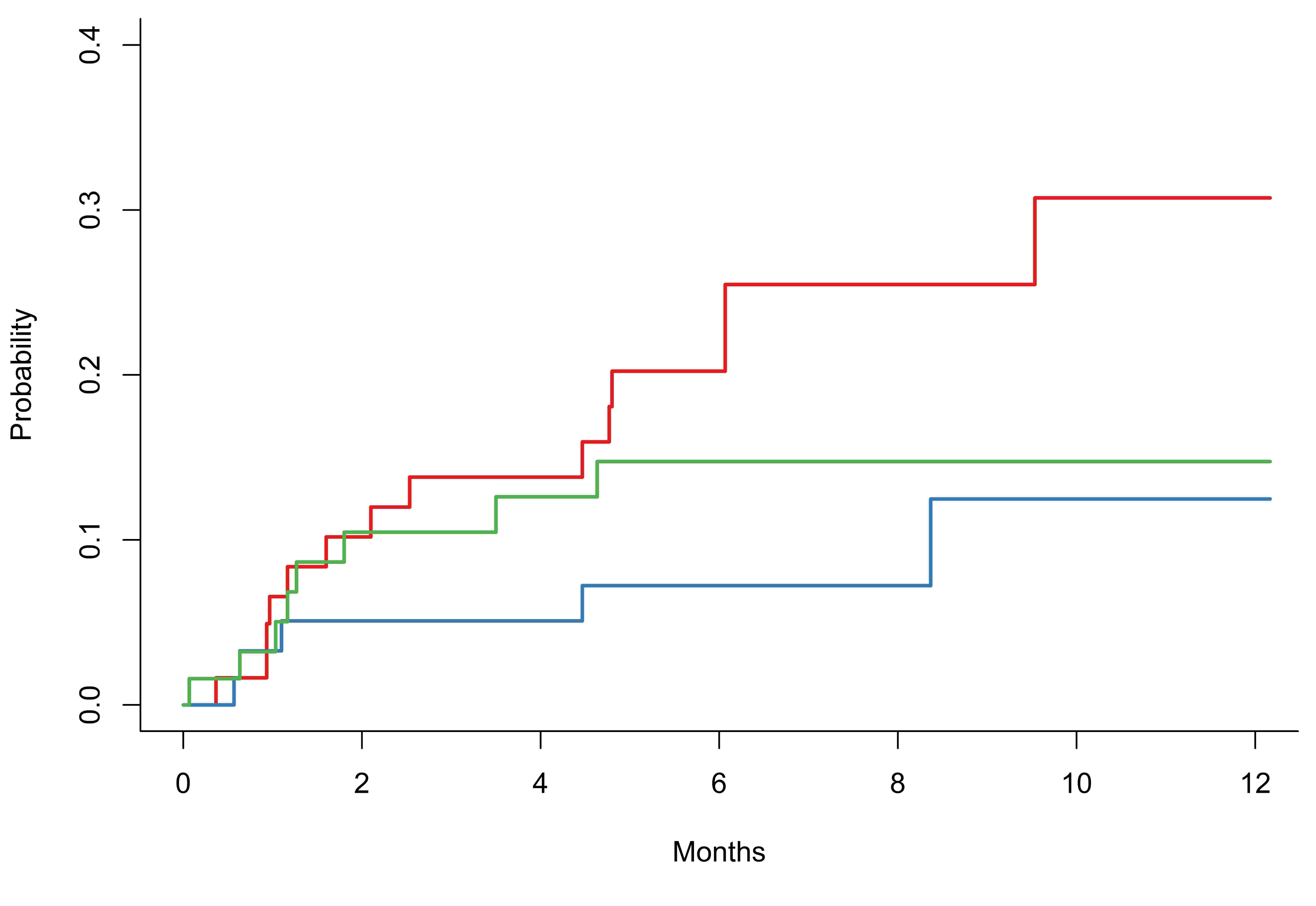Sunday Poster Session
Category: Liver
P1145 - Patients Have Poor One Year Outcomes After Requiring Large Volume Paracentesis
Sunday, October 27, 2024
3:30 PM - 7:00 PM ET
Location: Exhibit Hall E

Has Audio

Max Macgregor, MS
University of Michigan
Ann Arbor, MI
Presenting Author(s)
Max Macgregor, MS1, Nikhilesh Mazumder, MD2, Elliot Tapper, MD2, Anna Lok, MD2
1University of Michigan, Ann Arbor, MI; 2University of Michigan Medical School, Ann Arbor, MI
Introduction: Ascites is the most common complication of cirrhosis, and diuretic-refractory or intolerant ascites is often managed by paracentesis. Although the need for therapeutic paracentesis is known to portend poor outcomes for patients with cirrhosis, patient trajectories and predictors of outcomes after first therapeutic paracentesis are not known.
Methods: Adult patients with non-malignant ascites undergoing outpatient therapeutic paracentesis at a tertiary care liver transplant center were approached for consent between 12/2022 and 6/2024. Patients were excluded if they had CKD stage IV or greater. Chart follow up was performed at 7, 30, 90, 180 and 365 days after index paracentesis. The primary outcome was death, transjugular intrahepatic portosystemic shunt (TIPS) placement, or liver transplantation. Cumulative incidence analysis was performed to characterize trajectories after first therapeutic paracentesis.
Results: 63 patients consented and presented for 168 paracenteses during the study period. Of these procedures 26 did not have sufficient fluid to drain. Patients were followed for an average of 136 days and were a mean of 60 years old, 73% (n=46) were male, with liver disease most commonly caused by alcohol (n=30, 48%) and MASLD (n=21, 33%). Mean (SD) Total Bilirubin was 3.8 (4.8), Sodium 135 (5.3), albumin 3.2 (0.5), INR 1.4 (0.4), Creatinine (1.04), and MELD 3.0 16.5 (6.2). At one year, the cumulative incidence of death was 30.7% as compared to a 12.5% and 14.8% cumulative incidence of TIPS or Transplant respectively. Cumulative incidence appeared similar for outcomes at one month after first paracentesis but diverged afterwards (Figure). Higher MELD 3.0 score was associated with transplant (sHR 1.9 per 5 points of MELD, p=0.002) but not with TIPS or Death.
Discussion: Despite access to transplantation and TIPS, patients who present for therapeutic paracentesis are at high risk of death within one year.

Disclosures:
Max Macgregor, MS1, Nikhilesh Mazumder, MD2, Elliot Tapper, MD2, Anna Lok, MD2. P1145 - Patients Have Poor One Year Outcomes After Requiring Large Volume Paracentesis, ACG 2024 Annual Scientific Meeting Abstracts. Philadelphia, PA: American College of Gastroenterology.
1University of Michigan, Ann Arbor, MI; 2University of Michigan Medical School, Ann Arbor, MI
Introduction: Ascites is the most common complication of cirrhosis, and diuretic-refractory or intolerant ascites is often managed by paracentesis. Although the need for therapeutic paracentesis is known to portend poor outcomes for patients with cirrhosis, patient trajectories and predictors of outcomes after first therapeutic paracentesis are not known.
Methods: Adult patients with non-malignant ascites undergoing outpatient therapeutic paracentesis at a tertiary care liver transplant center were approached for consent between 12/2022 and 6/2024. Patients were excluded if they had CKD stage IV or greater. Chart follow up was performed at 7, 30, 90, 180 and 365 days after index paracentesis. The primary outcome was death, transjugular intrahepatic portosystemic shunt (TIPS) placement, or liver transplantation. Cumulative incidence analysis was performed to characterize trajectories after first therapeutic paracentesis.
Results: 63 patients consented and presented for 168 paracenteses during the study period. Of these procedures 26 did not have sufficient fluid to drain. Patients were followed for an average of 136 days and were a mean of 60 years old, 73% (n=46) were male, with liver disease most commonly caused by alcohol (n=30, 48%) and MASLD (n=21, 33%). Mean (SD) Total Bilirubin was 3.8 (4.8), Sodium 135 (5.3), albumin 3.2 (0.5), INR 1.4 (0.4), Creatinine (1.04), and MELD 3.0 16.5 (6.2). At one year, the cumulative incidence of death was 30.7% as compared to a 12.5% and 14.8% cumulative incidence of TIPS or Transplant respectively. Cumulative incidence appeared similar for outcomes at one month after first paracentesis but diverged afterwards (Figure). Higher MELD 3.0 score was associated with transplant (sHR 1.9 per 5 points of MELD, p=0.002) but not with TIPS or Death.
Discussion: Despite access to transplantation and TIPS, patients who present for therapeutic paracentesis are at high risk of death within one year.

Figure: Cumulative Incidence of Transplant, TIPS, or Death after First Paracentesis
Red line – Death
Green line – Transplant
Blue line – TIPS
Red line – Death
Green line – Transplant
Blue line – TIPS
Disclosures:
Max Macgregor indicated no relevant financial relationships.
Nikhilesh Mazumder indicated no relevant financial relationships.
Elliot Tapper indicated no relevant financial relationships.
Anna Lok indicated no relevant financial relationships.
Max Macgregor, MS1, Nikhilesh Mazumder, MD2, Elliot Tapper, MD2, Anna Lok, MD2. P1145 - Patients Have Poor One Year Outcomes After Requiring Large Volume Paracentesis, ACG 2024 Annual Scientific Meeting Abstracts. Philadelphia, PA: American College of Gastroenterology.
